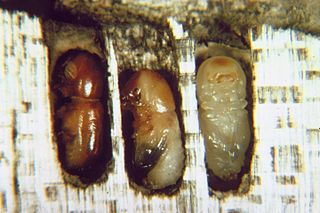
The tundra swan is a small Holarctic swan. The two taxa within it are usually regarded as conspecific, but are also sometimes split into two species: Bewick's swan of the Palaearctic and the whistling swan proper of the Nearctic. Birds from eastern Russia are sometimes separated as the subspecies C. c. jankowskii, but this is not widely accepted as distinct, with most authors including them in C. c. bewickii. Tundra swans are sometimes separated in the subgenus Olor together with the other Arctic swan species.

The Venezuelan wood quail is a species of bird in the Odontophoridae family. It is found in the Venezuelan Coastal Range. Its natural habitat is subtropical or tropical moist montane forests. It is threatened by habitat loss.

Dendropsophus columbianus is a species of frog in the family Hylidae. It is endemic to the Andes of Colombia. Dendropsophus columbianus is a common and adaptable species that lives in disturbed areas that formerly supported cloud forests; it has not been found in closed forests. It is typically associated with open habitats, especially those with some waterbodies.

The Columbian ground squirrel, is a species of rodent common in certain regions of Canada and the northwestern United States. It is the second largest member of the genus Urocitellus, which is part of the tribe Marmotini, along with marmots, chipmunks, prairie dogs, and other holarctic ground squirrels. They are stout, with short dense fur, which is characteristically tawny across the bridge of the nose. Social encounters often are initiated with kissing behavior and the most common activity above ground is standing at attention. Residing in mountainous terrain and high plains in northern latitudes, they hibernate most of the year in underground burrows, which may be used for many years. They are emaciated when emerging in the spring. These long periods of torpor earned the squirrels the moniker "Seven Sleepers", since the rests last around seven months. The Columbian ground squirrel came to the attention of the scientific community through writings produced by Lewis and Clark, while 21st century molecular genetics has more finely illuminated its ties with other close relatives.

Yaguarasaurus is an extinct genus of mosasauroid from the Late Cretaceous (Turonian) period of Colombia, South America. The remains discovered were defined as a new genus and species of mosasaurid, Yaguarasaurus columbianus, by the Colombian paleontologist María Páramo, former director of the Museo de Geología José Royo y Gómez of INGEOMINAS in Bogotá. The first fossils remains of this animal suggested a cranial length of 47 centimetres (19 in) and a total length of 5 metres (16 ft); an additional skull that measures 87 centimetres (34 in) long implies a larger size.

Corthylus columbianus, also known as the chestnut timber worm or the Columbian timber beetle, is a beetle of the family Curculionidae.
Ptericoptus is a genus of beetles in the family Cerambycidae, containing the following species:
Ptericoptus borealis is a species of beetle in the family Cerambycidae. It was described by Breuning in 1939. It is known from Mexico.
Ptericoptus intermedius is a species of beetle in the family Cerambycidae. It was described by Breuning in 1939. It is known from Mexico.
Ptericoptus meridionalis is a species of beetle in the family Cerambycidae. It was described by Breuning in 1939. It is known from Paraguay and Argentina.
Ptericoptus similis is a species of beetle in the family Cerambycidae. It was described by Breuning in 1939. It is known from Colombia and Venezuela.
Ptericoptus sinuatus is a species of beetle in the family Cerambycidae. It was described by Breuning in 1939. It is known from Colombia and Peru.
Ptericoptus acuminatus is a species of beetle in the family Cerambycidae. It was described by Johan Christian Fabricius in 1801. It is known from Argentina, Brazil and Paraguay.
Ptericoptus avanyae is a species of beetle in the family Cerambycidae. It was described by Martins and Galileo in 2010. It is known from Brazil.
Ptericoptus caudalis is a species of beetle in the family Cerambycidae. It was described by Bates in 1880. It is known from Guatemala, Honduras, and Mexico.
Ptericoptus clavicornis is a species of beetle in the family Cerambycidae. It was described by Johan Christian Fabricius in 1801. It is known from Guyana and French Guiana.
Ptericoptus corumbaensis is a species of beetle in the family Cerambycidae. It was described by Galileo and Martins in 2003. It is known from Brazil.
Ptericoptus dorsalis is a species of beetle in the family Cerambycidae. It was described by Audinet-Serville in 1835. It is known from Brazil.
Ptericoptus griseolus is a species of beetle in the family Cerambycidae. It was described by Bates in 1880. It is known from Guatemala.
Ptericoptus panamensis is a species of beetle in the family Cerambycidae. It was described by Bates in 1880. It is known from Panama.








